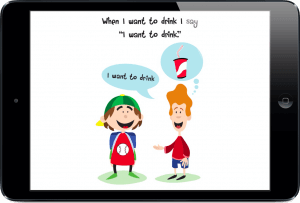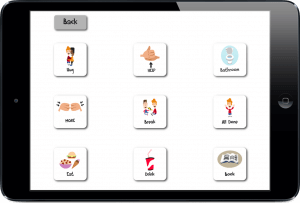A social story & simple visual support to teach talking, and beginning speech and language skills

Mands are usually taught first when teaching language to a child for several reasons. The most obvious reason is that the child will be highly motivated to learn this type of language because it helps them get what they want. When they say “drink” and it is immediately reinforced with something to drink it is likely they will say “drink” again in the future when they are thirsty. Another reason is that studies with children with autism have shown that even when they know the name of an object and can say it, they still need to be taught to request it. Another reason mands are usually taught first is because many problem behaviors occur due to a child needing or wanting something, but not being able to ask for it. This is why we are always reminding our kiddos to “use your words!”
This app is a “first step” for children who are not yet making requests. It is a very simple app to teach the beginning stages of asking for things, or “using words” to get what they need or want.


The chart can be used with verbal children as a visual prompt. The appropriate button on the chart can be pointed to, to prompt the child to ask for what the picture represents. Physical prompts like pointing can be easier to fade out than verbal prompts. The button can even be pressed to say the request, and then repeated by the child. This can then be faded by turning the sound off and touching the button to prompt the child to verbally make the request on their own. Once this step is mastered the prompt can be faded to simply pointing to the button, and then gradually the pointing finger can be moved farther and farther away from the button until the whole chart is being gestured to.
The chart can also be used with non-verbal children with the goal being that they eventually use it independently. To fade prompting for non-verbal children you can use hand-over-hand to have them push the appropriate button for a request. The request through the app must be immediately reinforced with whatever was asked for. The “hand-over-hand” prompt can then be faded by moving your hand farther and farther away from the child’s hand, eventually teaching them to open the app independently to use the chart to make simple requests.
Apple, the Apple logo, and iPad are trademarks of Apple Inc., registered in the U.S. and other countries. App Store is a service mark of Apple Inc.